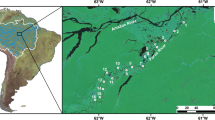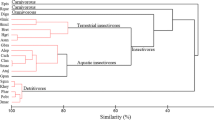Synopsis
The spatio-temporal availability to, and use of terrestrial (allochthonous) prey by, a subset of the fish assemblage of a Virginia piedmont stream were investigated during spring and summer. Terrestrial invertebrates were most abundant in drift nets, but least common in fish stomachs, during April. In contrast, during August, terrestrial prey dominated the diet of the major cyprinid fish,Notropis ardens, even though terrestrial prey availability in the stream declined by an order of magnitude. Several other co-occurring fishes only rarely consumed prey of terrestrial origin. Drifting terrestrial invertebrates, were concentrated at the surface near the thalweg, compared to stream margin or substrate locations. This study suggests that morphologial and behavioral constraints of individual fish taxa, including predator avoidance responses, regulate the use of terrestrial prey within a given fish assemblage.
Similar content being viewed by others
References cited
Angermeier, P. L. 1985. Spatio-temporal patterns of foraging success for fishes in an Illinois stream. Amer. Midl. Nat. 114: 342–359.
Angermeier, P. L. & J. R. Karr. 1983. Fish communities along environmental gradients in a system of tropical streams. Env. Biol. Fish. 9: 117–135.
Baker, J. A. & S. T. Ross. 1981. Spatial and temporal resource utilization by southeastern cyprinids. Copeia 1981: 178–189.
Bowen, S. H. 1979. A nutritional constraint in herbivory by fishes: a stunted population ofSarotherodon mossambicus (Peters) in Lake Sibaya. Ecol. Monogr. 49: 17–31.
Cerri, R. D. & D. F. Fraser. 1983. Predation and risk in foraging minnows: balancing conflicting demands. Amer. Nat. 121: 552–561.
Cochran, P. A., D. M. Lodge, J. R. Hodgson & P. G. Knapik. 1988. Diets of syntopic fine scale dace,Phoxinus neogaeus, and northern redbelly dace,Phoxinus eos: a reflection of trophic morphology. Env. Biol. Fish. 22: 235–240.
Crossley, D. A., C. S. Gist, W. W. Hargrove, L. S. Risley, T. O. Schowalter & T. R. Seastedt. 1988. Foliage consumption and nutrient dynamics in canopy insects. pp. 193–205.In: W. T. Swank & D. A. Crossley (ed.) Forest Ecology and Hydrology at Coweeta, Springer-Verlag, New York.
Ellison, J. P. 1980. Diets of mountain whitefish,Prosopium williamsoni, and brook trout,Salvelinus fontinalis in the Little Walker River, Mono County, California. Calif. Fish and Game 66: 96–104.
Fisher, W. L. & W. D. Pearson. 1987. Patterns of resource utilization among four species of darters in three central Kentucky streams. pp. 69–76.In: W. J. Matthews & D. C. Heims (ed.) Community and Evolutionary Ecology of North American Stream Fishes, University of Oklahoma Press, Norman.
Furukawa-Tanaka, T. 1985. The ecology of salmonid fishes in Japanese mountain streams. Jap. J. Ecol. 35: 481–504.
Garman, G. C. 1984. Initial effects of deforestation on aquatic community structure and function of the East Branch Piscataquis River, Maine. Ph. D. Dissertation, University of Maine, Orono. 105 pp.
Garman, G. C. & L. A. Smock. 1988. James River investigation report. U. S. Fish Wildl. Serv. Proj. F-74-R. 78 pp.
Gatz, A. J. 1979. Ecological morphology of freshwater stream fishes. Tulane Stud. Zool. Bot. 21: 91–124.
Gorman, O. T. 1987. Habitat segregation in an assemblage of minnows in an Ozark stream. pp. 33–41.In: W. J. Matthews & D. C. Heims (ed.) Community and Evolutionary Ecology of North American Stream Fishes. University of Oklahoma Press, Norman.
Grossman, G. D. & M. C. Freeman. 1987. Microhabitat use in a stream fish assemblage. J. Zool., Lond. 212: 151–176.
Hunt, R. L. 1975. Use of terrestrial invertebrates as food by salmonids. pp. 137–152.In: A. D. Hasler (ed.) Coupling of Land and Water Systems, Springer-Verlag, New York.
Hynes, H. B. N. 1970. The ecology of running waters. University of Toronto Press, Toronto. 555 pp.
Johnson, J. H. & E. Z. Johnson. 1982. Diel foraging in relation to available prey in an Adirondack mountain stream. Hydrobiologia 96: 97–104.
Keast, A. & D. Webb. 1966. Mouth and body form relative to feeding ecology in the fish fauna of a small lake, Lake Opinicon, Ontario. J. Fish. Res. Board Can. 23: 1845–1874.
Lotrich, V. A. 1973. Growth, production, and community composition of fishes inhabiting a first-, second-, and third-order stream of eastern Kentucky. Ecol. Monogr. 43: 377–397.
Lowe-McConnell, R. H. 1964. The fishes of the Rupununi savanna district of British Guiana, South America. J. Linn. Soc. Lond. Zool. 45: 103–144.
Magurran, A. E. & T. J. Pitcher. 1983. Foraging timidity, and shoal size in minnows and goldfish. Behav. Ecol. Sociobiol. 12: 147–152.
Mason, C. F. & S. M. MacDonald. 1982. The input of terrestrial invertebrates from three canopies to a stream. Freshw. Biol. 12: 305–311.
Massmann, W. H. 1963. Summer food of juvenile American shad in Virginia waters. Ches. Sci. 4: 167–171.
McLemore, C. E. & W. R. Meehan. 1988. Invertebrates of Meadow Creek, Union County, Oregon, and their use as food by trout. U. S. Dept. Agric. For. Serv., Res. Paper PNW-RP-394. 13 pp.
O'Hop, J. & J. B. Wallace. 1983. Invertebrate drift, discharge, and sediment relations in a southern Appalachian headwater stream. Hydrobiologia 98: 71–84.
Power, M. E. 1984. Depth distributions of armored catfish: Predator-induced resource avoidance? Ecology 65: 523–528.
Prejs, A. 1987. Risk of predation and feeding rate in tropical fishes: field evidence. Oecologia 72: 259–262.
Prejs, A. & K. Prejs. 1987. Feeding of tropical freshwater fishes: seasonality in resource availability and resource use. Oecologia 71: 397–404.
Schlosser, I. J. 1987. The role of predation in age- and sizerelated habitat use by stream fishes. Ecology 68: 651–659.
Skinner, W. D. 1985. Size selection of food by cutthroat trout,Salmo clarki, in an Idaho stream. Great Basin Nat. 45: 327–332.
Statzner, B. & B. Higler. 1986. Stream hydraulics as a major determinant of benthic invertebrate zonation patterns. Freshw. Biol. 16: 127–139.
Surber, E. W. 1951. Bottom fauna and temperature conditions in relation to trout management in St. Mary's River, Augusta County, Virginia. Virginia J. Sci. 2: 190–201.
Vannote, R. L., G. W. Minshall, K. W. Cummins, J. R. Sedell & C. E. Cushing. 1980. The river continuum concept. Can. J. Fish. Aquatic Sci. 37: 130–137.
Weatherley, N. S. 1987. The diet and growth of O-group dace,Leuciscus leuciscus (L.), and roachRutilus rutilus (L.), in a lowland river. J. Fish Biol. 30: 237–247.
Werner, E. E. & D. S. Hall, 1988. Ontogenetic habitat shifts in bluegill: the foraging rate-predation risk trade-off. Ecology 69: 1352–1366.
Author information
Authors and Affiliations
Rights and permissions
About this article
Cite this article
Garman, G.C. Use of terrestrial arthropod prey by a stream-dwelling cyprinid fish. Environ Biol Fish 30, 325–331 (1991). https://doi.org/10.1007/BF02028848
Received:
Accepted:
Issue Date:
DOI: https://doi.org/10.1007/BF02028848




